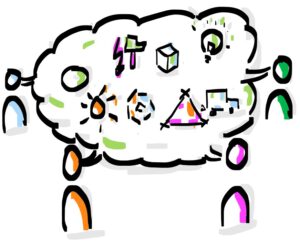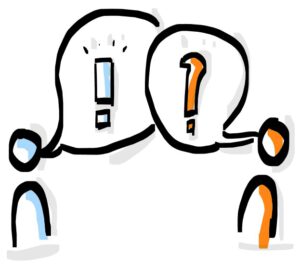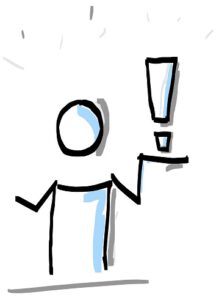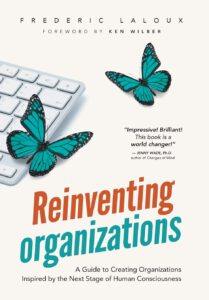Problem talking creates problems.
Solution talking creates solutions.
We need to talk. And we need to talk about the right things. In a good way. At least that’s what we should do if we want to successfully change. A few thoughts on a very important aspect of change projects.

Everywhere there is nervousness, unease, sometimes even sheer fear about the much talked about disruptive and transformative forces that are affecting so many industries in so many ways and reshaping so many established businesses in the process these days.
It is getting uncomfortable. And that’s even though it’s such a pain in the neck for us. As (supposedly very intelligent) creatures of habit, we humans don’t like disruption at all. We prefer familiar routines, well-rehearsed processes and ways of thinking. So we try to eliminate disturbances as quickly as possible. We even fight the more insistent ones. Alternatively, we simply ignore what makes life difficult for us. Let them vanish!
Only when all this is of no use and we have no other choice we start to change and adapt to the new situation. Even though this means leaving our cosy comfort zone with all those patterns that have made us successful so far.
Problem talking creates problems…
Today, more and more people, teams, companies, even entire industries and – frankly – even entire societies find themselves in precisely this delicate situation, which is difficult to handle and reflect upon emotionally and cognitively.
Having spent the last few years putting a lot of energy into defensive battles against the disruptors (and the disruption itself), more and more people seem to be realising: We have to change. Even if it’s hard for us to do so. Let’s deal with it!
But: How? What needs to be done? How does “one” actually change? In general? And in terms of organisation? What does that mean for us? In our specific situation? After all, we can’t be compared to anything else. We have always had special circumstances, we are quite unique…
Nothing is more practical than a good theory, they say, and rightly so. So let’s take a look at what systems theory has to say about how systems emerge and develop. After all, organisations are systems too. So what do they consist of? How do they function?
The Most Important Finding
 Organisations (or systems) do not consist of and develop from people, as one might easily assume. They are made of communications./1/ However, these communications are – of course – made by people. What may seem like an excessively theoretical hair-splitting exercise is actually meant to be very concrete and true to life. And also easy to understand:
Organisations (or systems) do not consist of and develop from people, as one might easily assume. They are made of communications./1/ However, these communications are – of course – made by people. What may seem like an excessively theoretical hair-splitting exercise is actually meant to be very concrete and true to life. And also easy to understand:
Everything we do together – all professional and private plans, all tasks we jointly carry out, companies, departments, projects, our business and private relationships, partner and friendships, associations, parties, all the way to state and society – all this originates from those very concrete things, issues and topics that we think, talk and write about in relation to them: In personal conversations, on the phone, in meetings, in the canteen, coffee kitchen and at parties, also in self-talk, in emails, minutes, social media, in blogs, newspapers, news programmes, talk shows, etc.
By communicating – and only by communicating (!) – we give life to our world. And thus also our organisation. And: By how and when, in which specific way and with whom we speak, write or communicate in any other way (also: when and with whom we do not do so), we shape it according to our preferences. In this way – and only in this way – we shape our organisation (and the world) the way it looks.
So what?
What is this insight supposed to help us in our situation, which demands that we change and adapt? That forces us to leave the comfort zone that consists of the economic and social institutions, corporate and organisational patterns that we have communicatively created in the course of the 20th century: Stable, hierarchical, ultra-clearly structured, performance-oriented, with strongly predefined structures and role definitions, responsibilities, production and marketing routines, career paths, power-oriented to the point of being coercive, even almost violent?
Well, it might be helpful to realise that for successful structural change or adaptation, there is literally one and only one means available: To communicate differently with each other (and that often means: to communicate at all); to talk about different things with other people in a different way; to choose different, new topics and words and to communicate them in different, new channels and forms; to meet other people in different circles, contexts and forums and to communicate, decide and document with them in a new way.
… solution talking creates solutions.
 In concrete terms, of course, this could lead to many things:
In concrete terms, of course, this could lead to many things:
- Replacing the seven-page protocol, which in reality no one has ever read, with the photo protocol with Post-Its on the wall.
- Setting up open forums, MeetUps, in which colleagues from different areas can work out more creative approaches that they can’t come up with in their silos.
- Start talking about solutions with colleagues from the neighbouring department instead of forever and again discussing who screwed something up (or finally clarifying who keeps screwing up what).
- Drop some of the many coordination committees and take decisions differently and more quickly in certain issues.
- Introduce language that focuses on solutions instead of problems.
- Replace command and order language with non-violent communication (or vice versa).
- As a manager, accept that it is no longer possible to know all the details of the technical issues. Discuss this “publicly”.
- Everyone – managers and team members – stop micromanaging (i.e. bite your tongue when you are in the process of explaining to the other person what he/she has to do and how).
- Draw circular instead of hierarchical organisational charts
- …

Yet, Why Should We Do This?
Because we know that what we have done so far, how we have shaped our world so far, how we have COMMUNICATED so far, is no longer good enough today. We are set to fail if we don’t adapt to the new circumstances.
Now it is a question of finding out what could help us in our current situation, which tends to be unstable and changing. Adjusting the way we talk to each other is the only way to create new routines of thought and action and thus structural organisational forms that are better suited to the changed environment.
In other words, consciously formed narratives – what we talk about and how we talk to each other (and what we decide to believe about it) and what and how we do not talk about it – is the only way to change and shape our organisations so that we can continue to be successful and do well with them. The more deliberately, purposefully and reflectively we decide on this together, and also the earlier we start, the better it will be for us, our projects and also our environment. Only in this way will we meet our responsibility and ensure that things develop in the right direction.
We want our change project to be good. So we should choose our words carefully. In times when words like “trade war” etc. are suddenly being used naturally, this advice seems particularly important to me.
This article was first published on www.teamworkblog.de on 25 November 2019.
Remarks
- /1/ And this is important: From “connectable” communications. Commands and orders do not usually belong in this category.
 Literature
Literature
- Appelo, Jurgen: How to change the world.
- Harari, Yuval Noaḥ: Homo Deus. A Brief History of Tomorrow
- Laloux, Frederic: Reinventing Organizations. A Guide to Creating Organizations.
